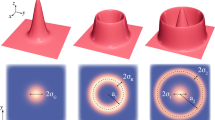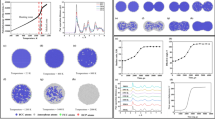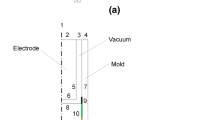Abstract
Thermal distribution during the sapphire growth process determines to a great extent the thermal stresses and dislocation density in sapphire. In this work, thermal and defect simulations of sapphire growth in a simplified single-boule furnace are presented. The heat transfer in the furnace is modeled via ANSYS Fluent® by considering conduction, convection and radiation effects. A dislocation density-based crystal plasticity model is applied for the numerical simulation of dislocation evolution during the crystal growth of sapphire. The physical models are validated by using a temporal series of measurements in the real furnace geometry, which capture the crystal–melt interface position during the technological growth process. The growth rate and the shape of the crystal growth front are analyzed for different side and top heater powers which result in different thermal distributions in the furnace. It is found that the cooling flux at the crucible bottom wall determines to a great extent the growth profile in the first half of the growth stage. Only toward the end of the growth stage, different top and side power distributions induce different growth front shapes. The effect of the convexity of the growth surface on the generation of dislocation defects is investigated by the crystal plasticity model. The results of simulations show that the convexity of the growth surface has a significant effect on the generation of dislocations.
Similar content being viewed by others
Notes
It shall be noted that a concave interface shape might not be practical in industrial applications because of some crystallographic problems such as the formation of low angle grain boundaries.
References
Bruni F (2015) Crystal growth of sapphire for substrates for high-brightness, light emitting diodes. Crys Res Technol 50(1):133–142
Bruni F (2013) Will Czochralski growth of sapphire once again prevail? Acta Phys Polon A 124:213–218
Xu C (2007) Thermal stresses and cracks during the growth of large-sized sapphire with SAPMAC method. Chin J Aeron 20:475–480
Kurlov V (2016) Sapphire: properties, growth and applications: In: Materials science and materials engineering. Oxford, Elsevier, pp 1–11
Demina S (2008) Use of numerical simulation for growing high-quality sapphire crystals by the Kyropoulos method. J Crys Growth 310:1443–1447
Ma W (2014) Numerical study of heat transfer during sapphire crystal growth by heat exchanger method. Int J Heat Mass Transf 72:425–460
Lu C-W (2001) Numerical computation of sapphire crystal growth using heat exchanger method. J Crys Growth 225:274–281
Zhang N (2013) Simulation of heat transfer and convection during sapphire crystal growth. J Crys Growth 367:27–34
Ma W (2017) Role of internal radiation in oxyde crystal growth by heat exchanger method. Crystals 7:18
Fang H (2013) Role of internal radiation at the different growth stages of sapphire by Kyropoulos method. Int J Heat Mass Trans 67:967–973
Yu QH (2012) Local design of the hot-zone in an industrial seeded directional solidification furnace for quasi-single crystalline silicon ingots. J Crys Growth 358:5–11
Chengai X (2007) Thermal stresses and cracks during the growth of large-sized sapphire with SAPMAC method. Chin J Aeron 20:475–480
Wu M (2016) Effect of crucible location on heat transfer in sapphire crystal growth by Heat Exchanger Method. Heat Transf Eng 37(3–4):332–340
Chen J (2004) Influence of the crucible geometry on the shape of the melt-crystal interface during growth of sapphire crystal using heat exchanger method. J Crys Growth 266:239–245
Ma A, Roters F, Raabe D (2006) A dislocation density based constitutive model for crystal plasticity FEM including geometrically necessary dislocations. Acta Mater 54(8):2169–2179
Lu P (2007) 3D simulation of the effects of growth parameters on the growth of sapphire crystals using heat exchanger method. Crys Res Technol 42:1259–1265
Voller V (1987) A fixed-grid numerical modeling methodology for convection-diffusion mushy region phase-change problems. Int J Heat Mass Transf 30:1709–1720
Qi X (2021) "Effect of internal radiation on heat transfer during ti:sapphire crystal growth process by heat exchanger method. Int J Heat Mass Transf 170:121000
Ma W (2017) Investigation of heat transfer and thermal stress during sapphire crystal. J Crys Growth 468:909–913
Chien (1952) https://de.wikipedia.org/wiki/Faustformelverfahren_(Automatisierungstechnik), [Online]
Roters F, Diehl M, Shanthraj P, Eisenlohr P, Reuber C, Wong SL, Maiti T, Ebrahimi A, Hochrainer T, Fabritius H-O (2019) DAMASK–the Düsseldorf advanced material simulation kit for modeling multi-physics crystal plasticity, thermal, and damage phenomena from the single crystal up to the component scale. Comput Mater Sci 158:420–478
Kronberg M (1962) Dynamical flow properties of single crystals of sapphire, I. J Am Ceram Soc 45(6):274–279
Sistaninia M, et al. (2024) Determination of the constitutive parameters of temperature and strain-rate dependent dislocation-density-based crystal plasticity model for single-crystalline sapphire
Gottstein G (2004) Physical foundations of materials science. Springer, Berlin
Dobrovinskaya ER, Lytvynov LA, Pishchik V (2009) Properties of sapphire. Sapphire: material, manufacturing, applications. Springer, Boston, pp 55–176
Acknowledgements
This project receives funding from FAMETEC GmbH and the Austrian Research Promotion Agency FFG.
Author information
Authors and Affiliations
Corresponding author
Ethics declarations
Conflict of interest
On behalf of all authors, the corresponding author states that there is no conflict of interest.
Additional information
Publisher's Note
Springer Nature remains neutral with regard to jurisdictional claims in published maps and institutional affiliations.
Rights and permissions
Springer Nature or its licensor (e.g. a society or other partner) holds exclusive rights to this article under a publishing agreement with the author(s) or other rightsholder(s); author self-archiving of the accepted manuscript version of this article is solely governed by the terms of such publishing agreement and applicable law.
About this article
Cite this article
Trasca, R.A., Sistaninia, M., Reiss, G. et al. Coupled Thermal Solidification Process Simulation of Sapphire Growth. Integr Mater Manuf Innov 13, 1–13 (2024). https://doi.org/10.1007/s40192-023-00321-7
Received:
Accepted:
Published:
Issue Date:
DOI: https://doi.org/10.1007/s40192-023-00321-7




